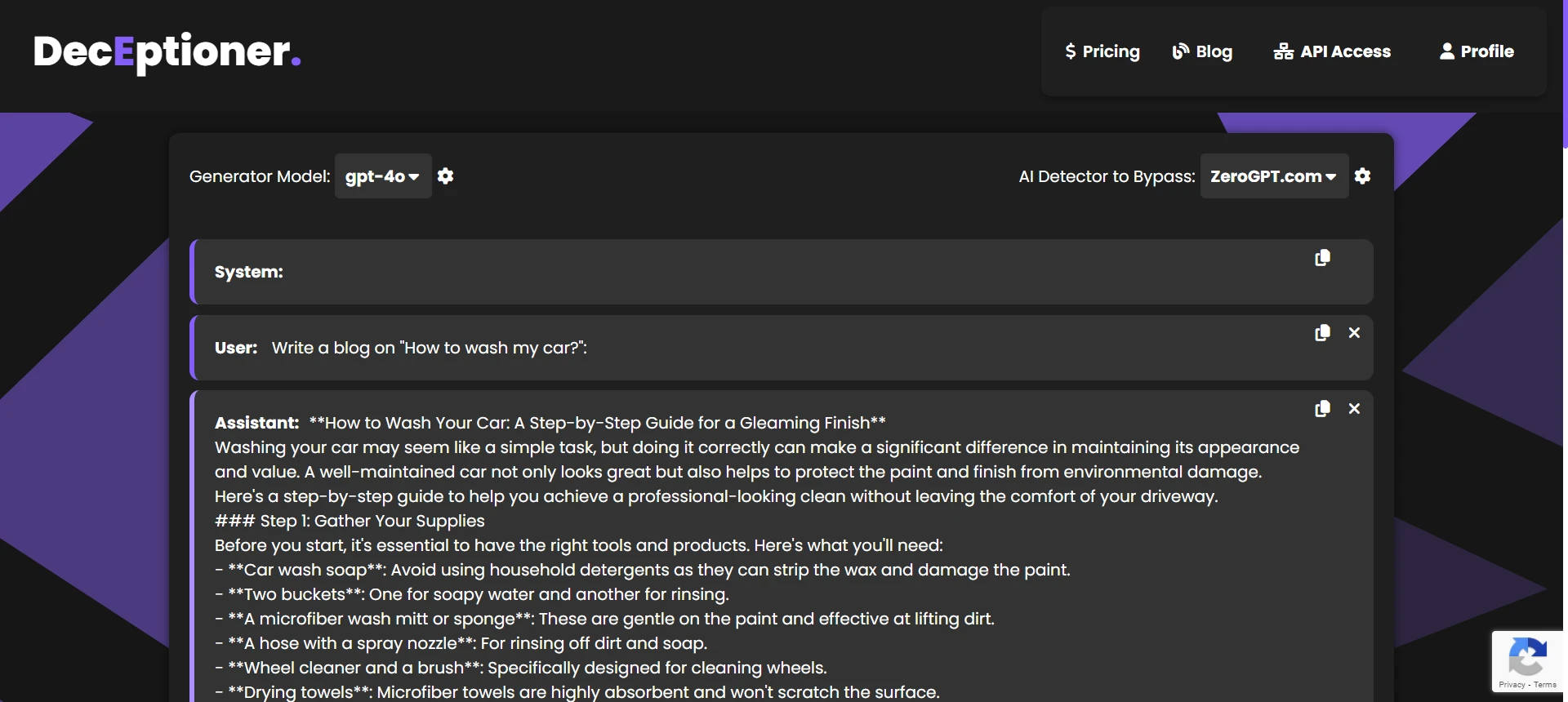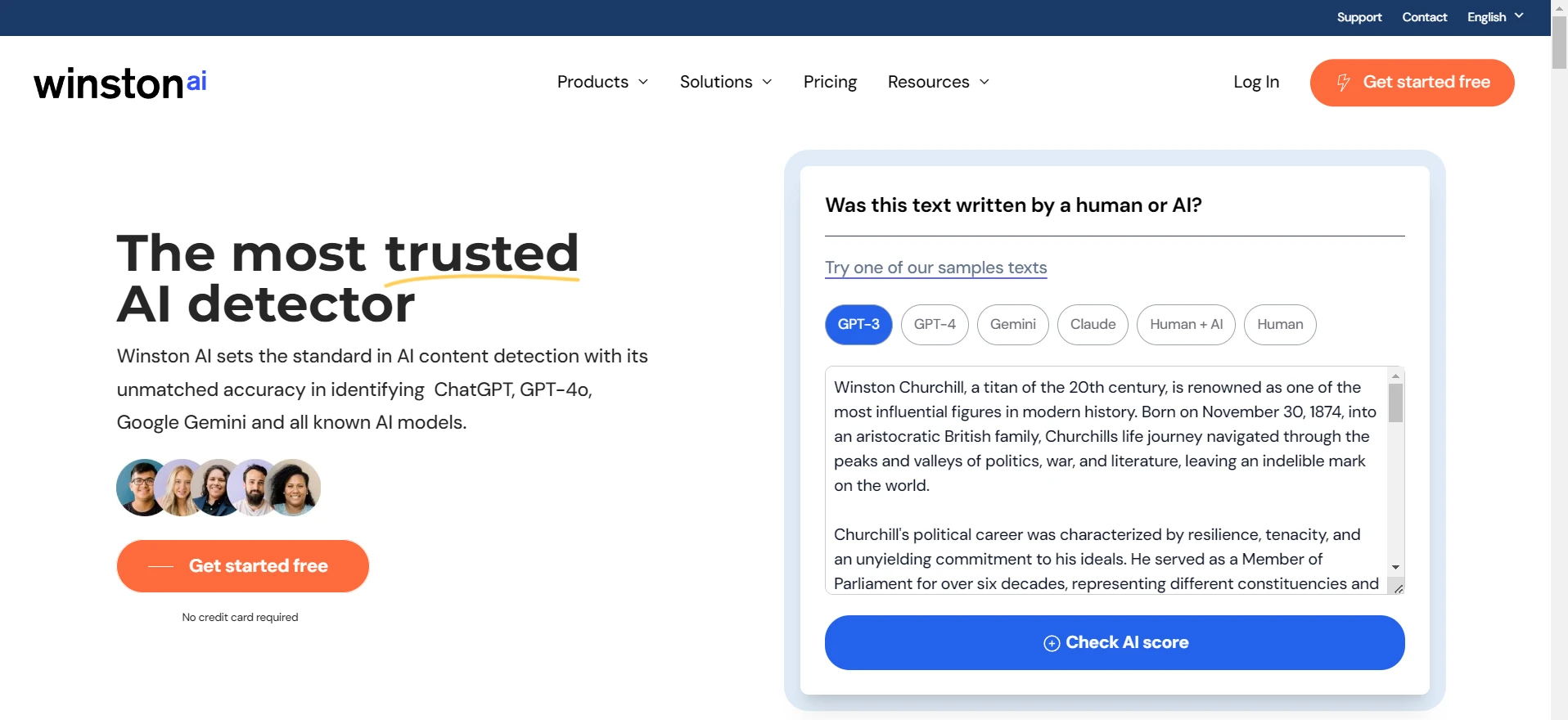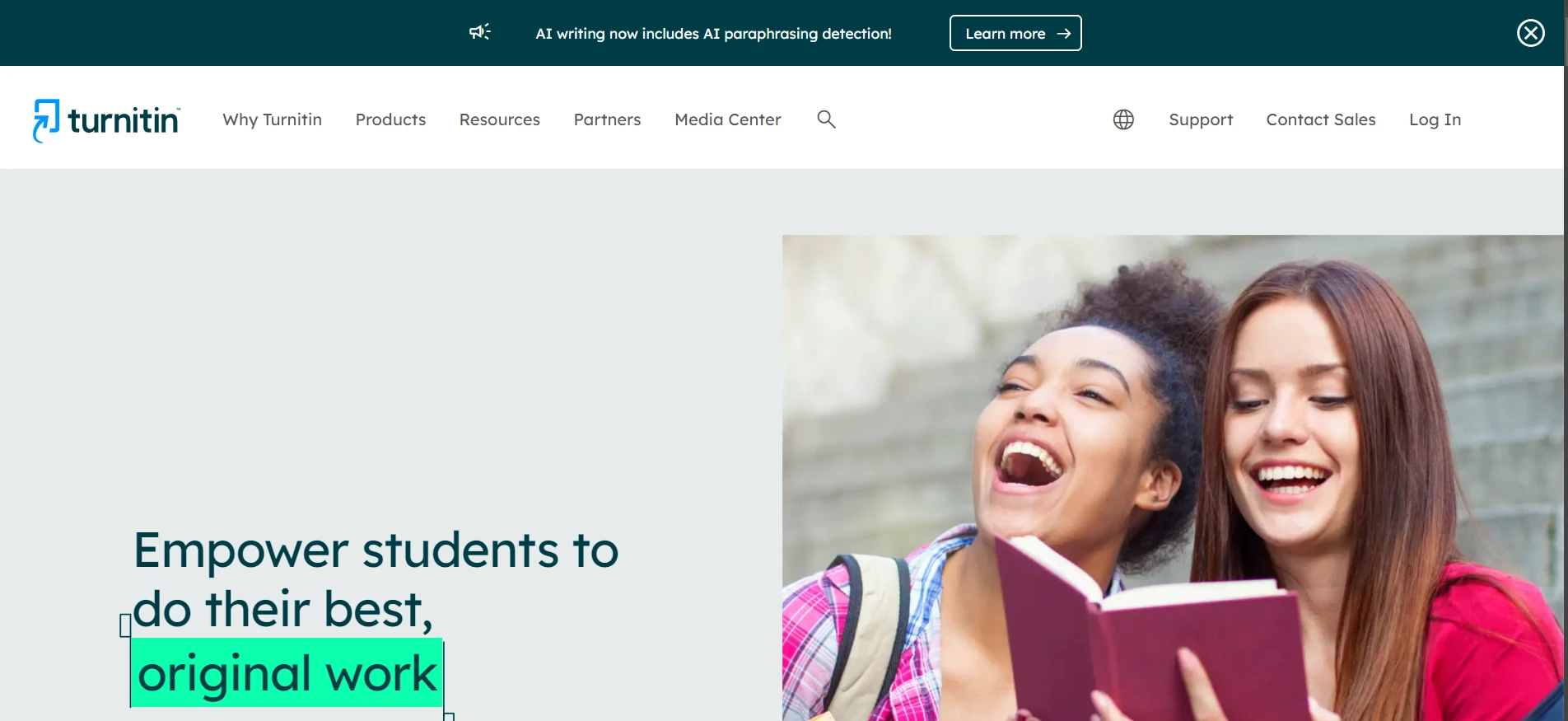As we all know, ZeroGPT is one of those AI detectors that claim to spot AI-generated content with high accuracy. But the real question that everybody is asking is, “Can ZeroGPT Detect GPT5?” The short answer is yes, in many cases. We tested around 202 samples and the results are quite interesting.
Why ZeroGPT can detect GPT5?
We created a dataset comprising 202 passages crafted by various GPT-5 models ourselves– for example, gpt-5, gpt-5-mini, gpt-5-nano, and gpt-5-chat-latest. Rather than relying on OpenAI's ever-changing frontend for the ChatGPT website/app (which labels its models inconsistently), we opted to use the OpenAI API.
It offers a neat set of stable labels. After all, any input made via the ChatGPT app/website inevitably goes to one of the underlying models; it just might not be labeled exactly as you see it. It’s worth noting that gpt-5, gpt-5-mini, and gpt-5-nano belong to a category of 'thinking' models.
On their API platform, they have a dropdown menu allowing users to select how much 'reasoning effort' they would like to apply: minimal (very easy), low, medium, or high (very hard). For our analysis, we all stuck with the default medium setting.
Meanwhile, gpt-5-chat-latest was the only model absent this reasoning feature. When gathering samples from it too, we kept things straightforward using its default settings (temp 1; top_p 1).
The simple reason is just like Turnitin or GPTZero, ZeroGPT uses a mix of text analysis, stylometry, and probably a big chunk of machine learning. They never explicitly advertise that they can detect GPT-5 seamlessly, but they do mention capabilities to detect advanced LLMs. However, you need to examine their results deeply to see how reliable they really are when it comes to GPT-5.
Which GPT-5 variant gets detected easily?
As it turns out, ZeroGPT has varying detection capabilities depending on which GPT-5 variant we are feeding it. It does exceptionally well with the chat-optimized ones, but it has a really tough time with the vanilla GPT-5 model. This is because GPT-5 comes in different variants—each one tuned for a unique purpose (some for chat, some for smaller tasks, etc.). If ZeroGPT is not made to specifically catch all GPT-5 variants, it won’t be able to consistently detect them all.
How well does ZeroGPT spot GPT-5 text?
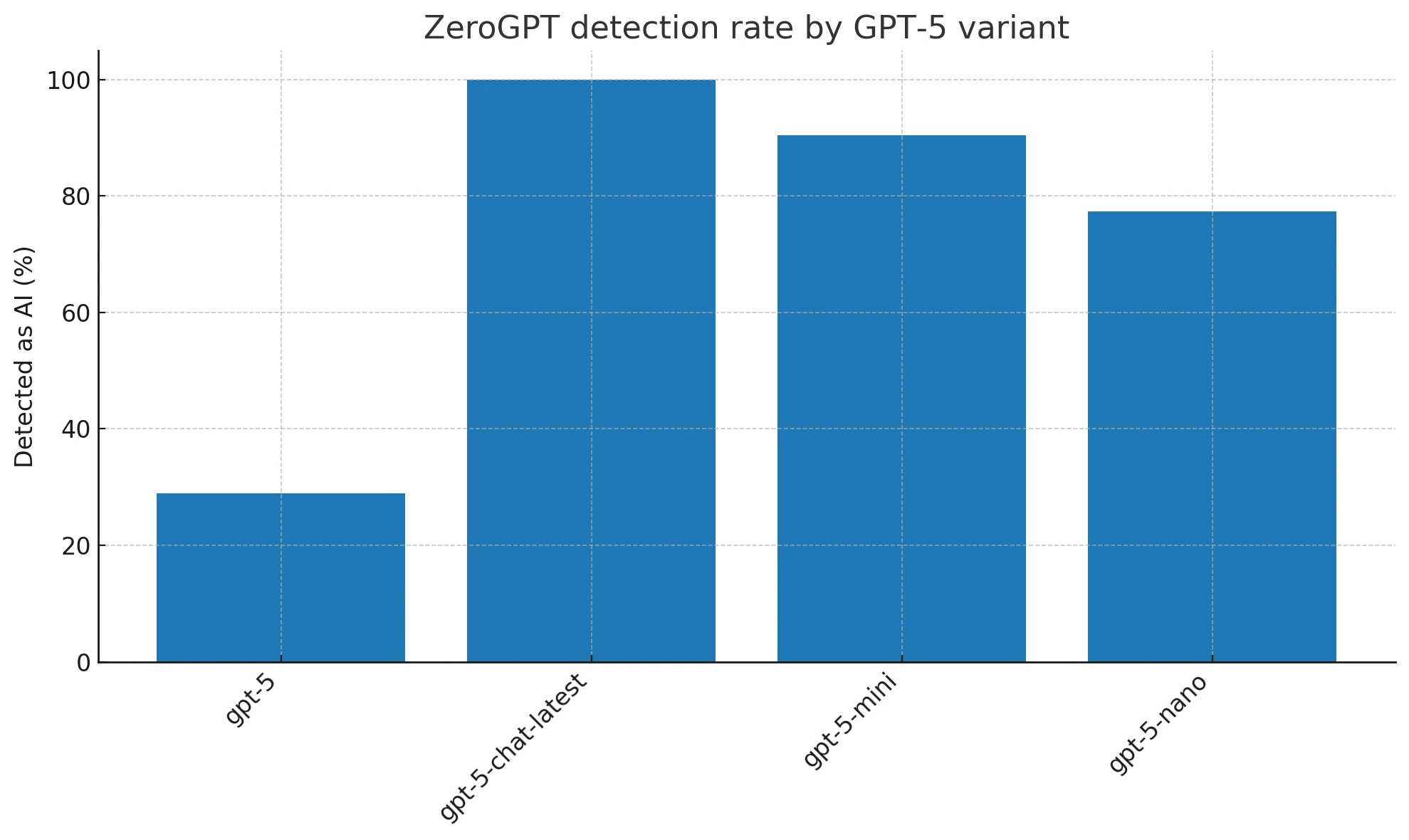
The short answer is that ZeroGPT flags about 76% of GPT-5 outputs as AI-written when we use their 50% threshold. This basically means that if ZeroGPT’s own score is above 50%, it labels the text as AI.
So, if you have 100 GPT-5 texts, it will manage to push around 76 of them into the AI pile. That’s not bad at all. However, about a quarter of the texts will still slip under the 50% mark and might be labeled as possibly human. For high-stakes situations like academic integrity or content moderation, that 1 in 4 could definitely cause issues.
If you really want a reliable way to bypass ZeroGPT then you need to use a dedicated humanizer like Deceptioner.
What the plots show
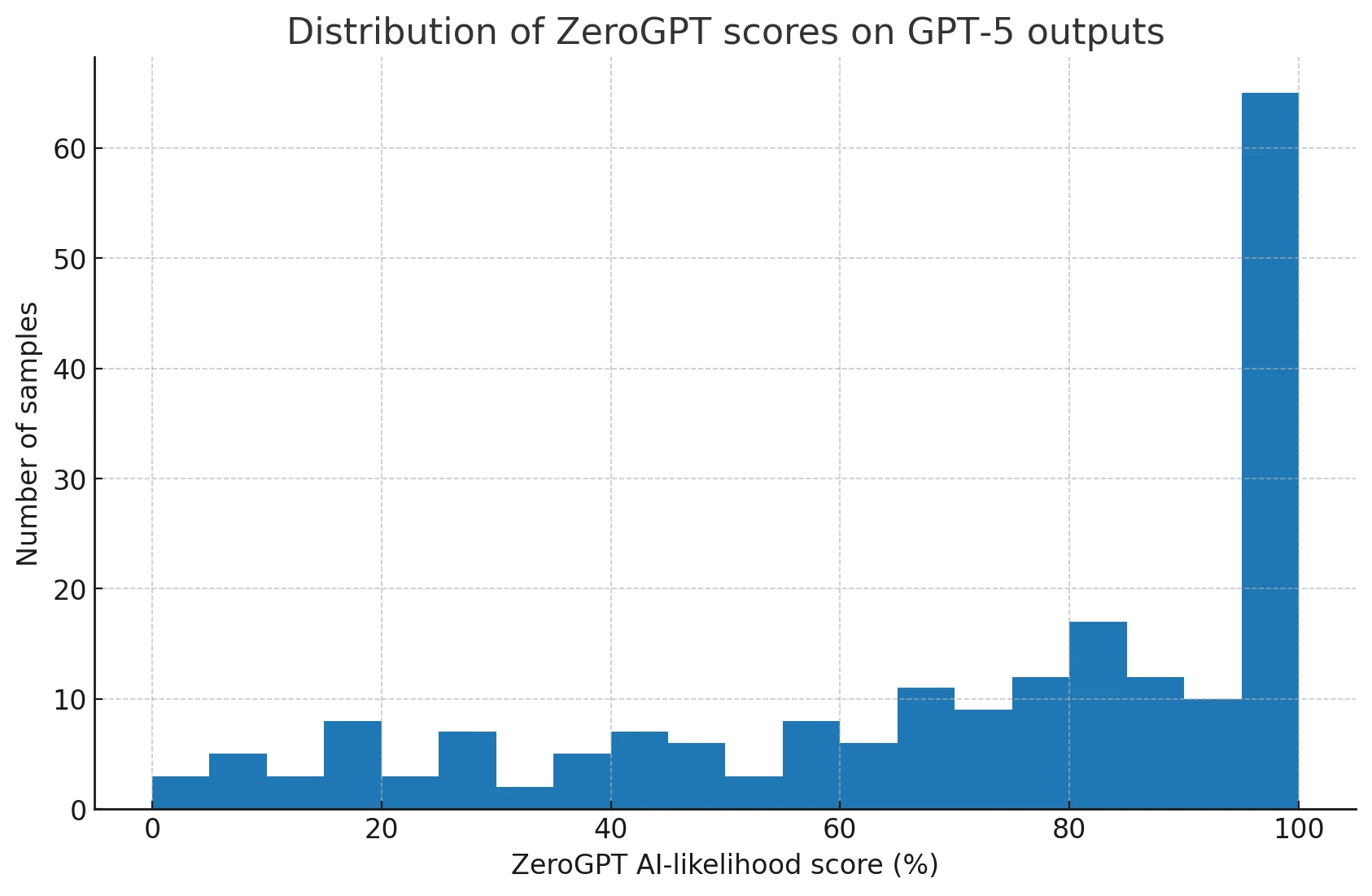
- Score distribution (histogram): In simpler terms, think of a big bucket that has all GPT-5 outputs in it. Most of those scores are crowding above the 50% detection mark, but there is a long left tail (a group of them) that is below 50%. That tail suggests that some GPT-5-generated text looks quite human-like, at least to ZeroGPT’s detection algorithm.
- Detection-rate bar chart: This is basically telling you how many texts, out of 100, get flagged for each GPT-5 variant. The catch-rate for the chat-latest model is perfect (100%). Meanwhile, the base GPT-5 variant is missed nearly 71% of the time (which is quite big).
Data Table
| Model | Samples | Mean Score | Detection Rate |
|---|---|---|---|
| gpt-5 | 45 | 40.15 | 0.29 |
| gpt-5-chat-latest | 52 | 95.20 | 1.00 |
| gpt-5-mini | 52 | 75.76 | 0.90 |
| gpt-5-nano | 53 | 70.50 | 0.77 |
Explanation of the table in simple English
- Model: Lists the GPT-5 variant names.
- Samples: How many text samples were tested from each variant.
- Mean Score: The average ZeroGPT probability score (the higher it is, the more “AI-like” ZeroGPT thinks the text is).
- Detection Rate: The fraction of texts (out of those samples) that were flagged as AI. For instance, 1.00 means 100% detection, and 0.77 means 77%.
Is ZeroGPT “reliable enough”?
- Strengths: If you are using GPT-5-chat-latest, it is almost guaranteed to get flagged by ZeroGPT. It also does a respectable job on the smaller GPT-5-mini and GPT-5-nano variants.
- Weak spots: The plain GPT-5 variant manages to slip by ZeroGPT most of the time. One in three attempts in this subset goes unnoticed—and that’s a big deal.
- Overall: A 76% recall means about 24% of the GPT-5 texts escape detection. If your use-case is critical, you probably want more than just ZeroGPT. Because it simply might not catch everything.
Why does the base GPT-5 get missed?
It could just be that the base GPT-5 variant writes text in a generic way that ZeroGPT has not been specifically tuned to detect. Maybe it’s missing some of the stylometric cues or rhetorical patterns that are easily found in chat-optimized or smaller models. And since ZeroGPT is not made exclusively to handle every GPT-5 style, it’s bound to let some slip through.
Frequently Asked Questions
Q1. Does ZeroGPT reliably detect all GPT-5 variants?
No, it excels at GPT-5-chat-latest, but fails with the plain GPT-5 variant about 71% of the time.
Q2. What do you mean by “1 in 4 misses”?
If ZeroGPT was given 100 GPT-5 texts, it would probably only detect 76 of them as AI and incorrectly let the remaining 24 pass as possibly human.
Q3. Should I rely solely on ZeroGPT for academic integrity?
No, it is not recommended. Because if 1 in 4 GPT-5 texts slip through, that’s a big risk for academic institutions that blindly trust its detection.
Q4. Why is ZeroGPT good at catching GPT-5-chat-latest?
Most likely because GPT-5-chat-latest might have certain patterns or structures that ZeroGPT is trained on. Chat-optimized models often leave behind more consistent AI “fingerprints.”
The Bottom Line
ZeroGPT is decent if you are only dealing with GPT-5-chat-latest, GPT-5-mini, or GPT-5-nano. However, it kind of fails at spotting the base GPT-5 variant, letting more than 70% pass through. It is not made to be the final authority on AI vs. human text. If you want a reliable approach, you need to combine ZeroGPT with other detection solutions or have multiple steps of checks.
While ZeroGPT might be a helpful signal, it’s not going to be your best bet if you need 100% detection accuracy right away. Humans are still needed in the loop—especially when you want reassurance that your text is indeed human or AI-generated. That being said, we can expect that these detectors will grow more sophisticated over time, but so will GPT-5. So, it’s basically a cat and mouse game, and it remains to be seen who truly wins.

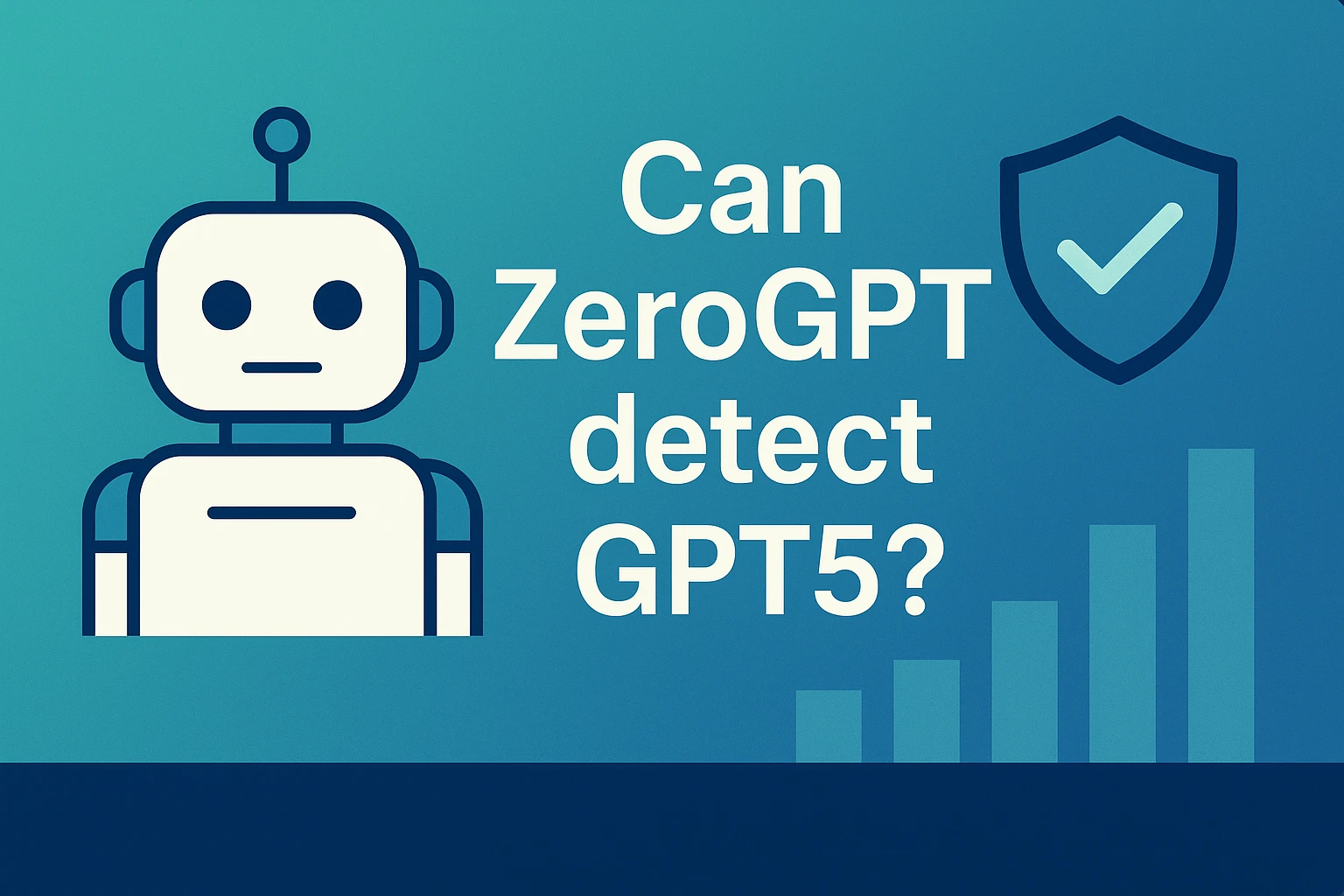
![[STUDY] Can Phrasly AI Humanizer Bypass ZeroGPT?](/static/images/can-phrasly-ai-humanizer-bypass-zerogptpng.webp)
![[STUDY] Can Phrasly AI Bypass Turnitin?](/static/images/can-phrasly-ai-bypass-turnitinpng.webp)
![[HOT TAKE] Is Winston AI or GPTZero more accurate?](/static/images/is-winston-ai-or-gptzero-more-accuratepng.webp)
![[NO NONSENSE ANSWER] Is Turndetect Permanently Down?](/static/images/is-turndetect-downpng.webp)
